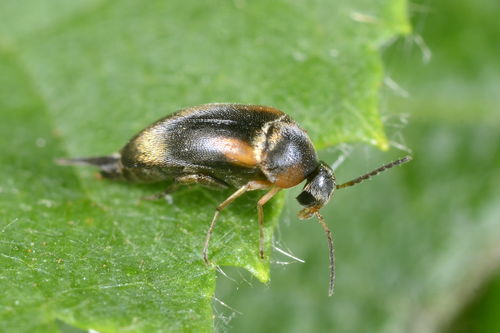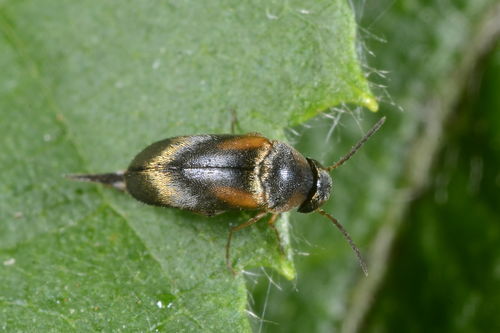Mordellistena (Mordellistena) variegata (Fabricius, 1798) (Coleoptera, Mordellidae) at Kidderminster
John Bingham & Denise Bingham
On 24 July 2014 Denise beat a small beetle from a Rowan tree in our garden (01, 02). It was quite well marked and colourful but belonged to a group of tumbling flower beetles Mordellistena, not easy to identify and with some quite rare species. Help was at hand and thanks to Paul Whitehead who identified the beetle from an image sent to him as Mordellistena (Mordellistena) variegata and provided information on distribution. In the note that follows he reports more fully on identifying species in this small group of interesting beetles.
The beetle is widespread but localised in the English midland region extending from lowland river floodplain level to at least 160 m a.s.l. on Bredon Hill, Worcestershire. Host trees include Pedunculate Oak Quercus robur L., Field Maple Acer campestre L. and now Rowan Sorbus aucuparia L. This last is perhaps unsurprising given that M. variegata is a well-known inhabitant of traditional pome fruit orchards in the region.
The Mordellidae or ‘tumbling flower beetles’.
Paul Whitehead
The Mordellidae or ‘tumbling flower beetles’ has always challenged human comprehension. The late Mr A. A. Allen, one of the greatest of the recent British coleopterists described new species of Mordellistena in both 1995 and 1999 neither of which have stood up to subsequent scrutiny. The group is generally well known for the apical abdominal segment being extended to form a so-called pygidium (Gr. pygidion = rump). This is especially conspicuous in the black Mordellistena which are especially speciose in southern Europe and which mostly breed in the rigid stems and rootstocks of Asteraceae, including Artemisia spp. and occasionally those of other groups such as Campanulaceae (e.g. Jasione).
Only three of the 12 British species of Mordellistena are not black viz. the scarce widespread M. neuwaldeggiana (Panzer, 1796) which is more or less uniformly brownish-orange and thus immediately recognisable; M. humeralis (L., 1758) which is variegated black and dull yellow-orange rarely with the pronotum darkened and M. variegata (F., 1798) which (in numerous examples seen) has clear orange vittae running obliquely away from the elytral humeri and the pronotum usually darkened but paler laterally and with the antennae longer. These three species are arboreal as larvae in a wide range of deciduous trees usually in soft delignified wood; M. neuwaldeggiana occurs in traditional orchards. In the English midlands I have numerous records of these species with the exception of M. humeralis which I have not yet seen in Britain. Male M. variegata have diagnostic subcircular last palpal segments whereas these are not dilated in male M. humeralis which also has relatively shorter antennae.
Other genera likely to be encountered in the region are Mordellochroa and Variimorda. Female Mordellochroa abdominalis (F., 1775) are unique and unmistakeable in the British fauna being black with clear red pronota; the males have darker pronota and may be confused with species of Mordellistena and Mordella. Ash (Fraxinus excelsior L.) is a known larval host in Worcestershire. Variimorda villosa (Schrank, 1781) is the only British representative of the genus and may be recognised by the pattern of shimmering bronze hairs forming transverse fasciae on the black elytra. Both of these robust species are arboreal as larvae although V. villosa has a demonstrable preference for Salicaceae in riparian situations. Mordella, a genus of mostly robust black species includes two British species which are either rare or localised; M. holomelaena Apfelbeck, 1914 may occur in the region but I am not aware of modern records.
For anyone wishing to acquaint themselves with the finer details of this group I would recommend perusal of Batten, R., 1986. A review of the British Mordellidae (Coleoptera). Entomologist’s Gazette 37:225-235. They might also consider forming a collection taking no more than a minimal number of specimens. As ‘tumbling flower beetles’ mordellids prefer to visit flowers with exposed nectaries, notably those in Rosaceae and Apiaceae and with records also from flowers of Sycamore Acer pseudoplatanus L. Finally (with a few clear exceptions) do not rely on the internet to inform decisions; many such images are based on misidentifications.
Images
01. Mordellistena variegata at Kidderminster. John Bingham.
02. Mordellistena variegata at Kidderminster. John Bingham.

